Abstract
BACKGROUND: A frozen section diagnostic service is often not directly available in small rural or mountain hospitals. In these cases, it could be possible to provide frozen section diagnosis through telepathology systems. Telepathology is based on two main methods: static and dynamic. The former is less expensive, but involves the crucial problem of image sampling. AIMS: To characterise the differences in image sampling for static telepathology when undertaken by pathologists with different experience. METHODS: As a test field, a previously studied telepathology method based on multimedia email was adopted. Using this method, three pathologists with different levels of experience sampled images from 155 routine frozen sections and sent them to a distant pathology institute, where diagnoses were made on digital images. After the telepathology diagnoses, the glass slides of both the frozen sections and the definitive sections were sent to the remote pathologists for review. RESULTS: Four of 155 transmissions were considered inadequate by the remote pathologist. In the remaining 151 cases, the telepathology diagnosis agreed with the gold standard in 146 (96.7%). There was no significant divergence between the three pathologists in their sampling of the images. Each case comprised five images on average, acquired in four minutes. The overall time for transmission was about 19 minutes. CONCLUSIONS: The results suggest that in routine frozen section diagnosis an inexperienced pathologist can sample images sufficiently well to permit remote diagnosis. However, as expected, the internet is too unreliable for such a time dependent task. An improvement in the system would involve integrated real time features, so that there could be interaction between the two pathologists.
Full text
PDF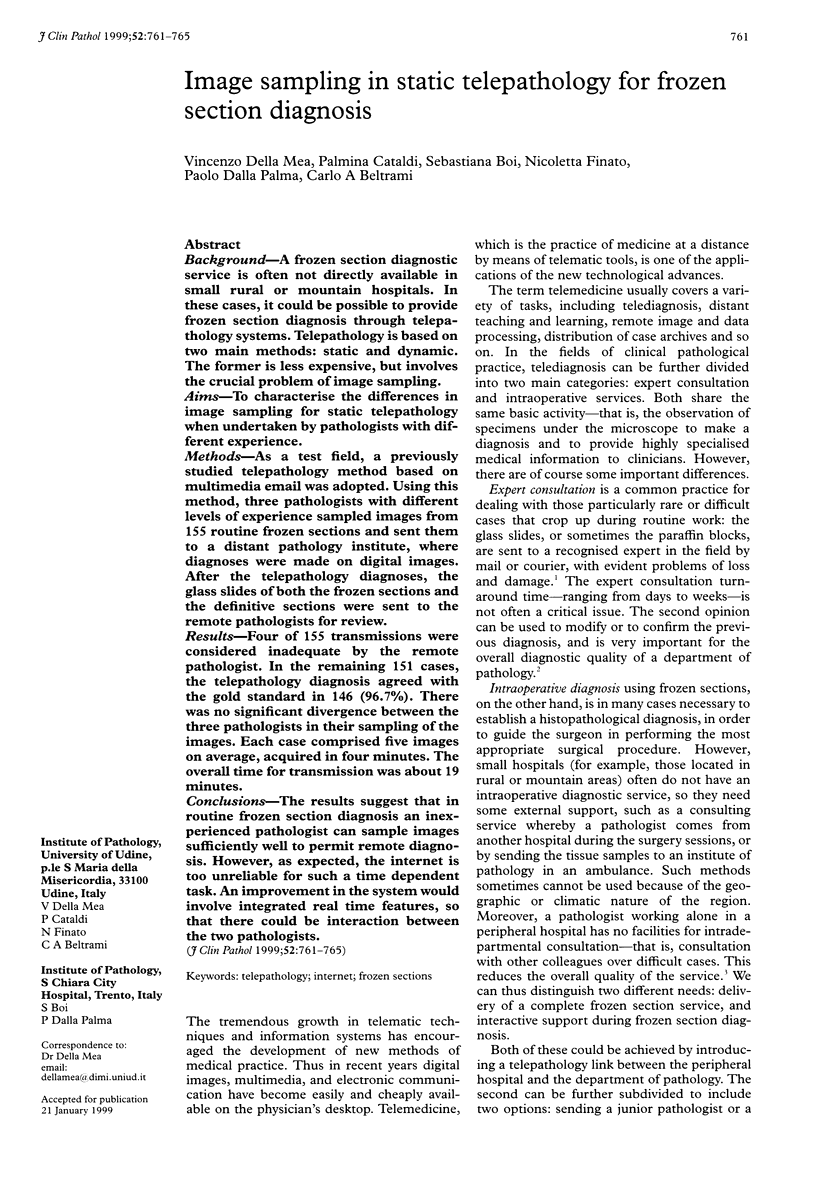
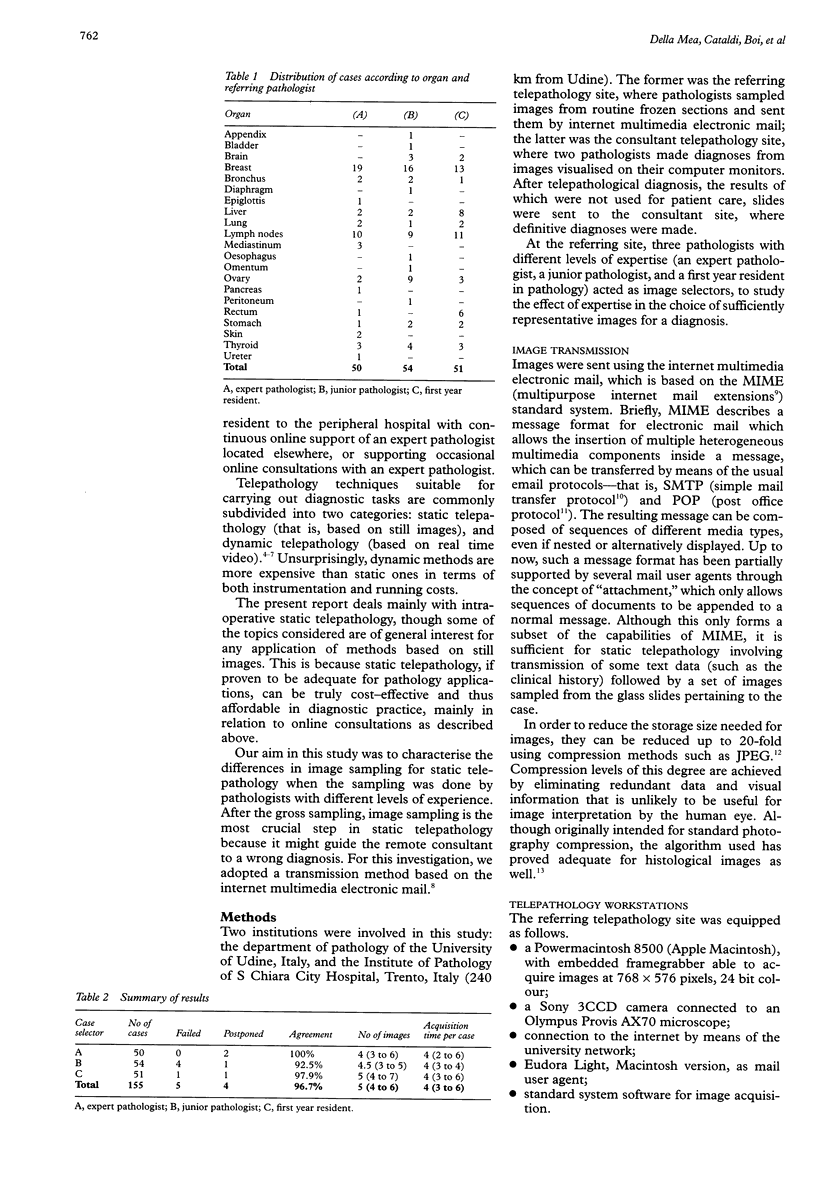
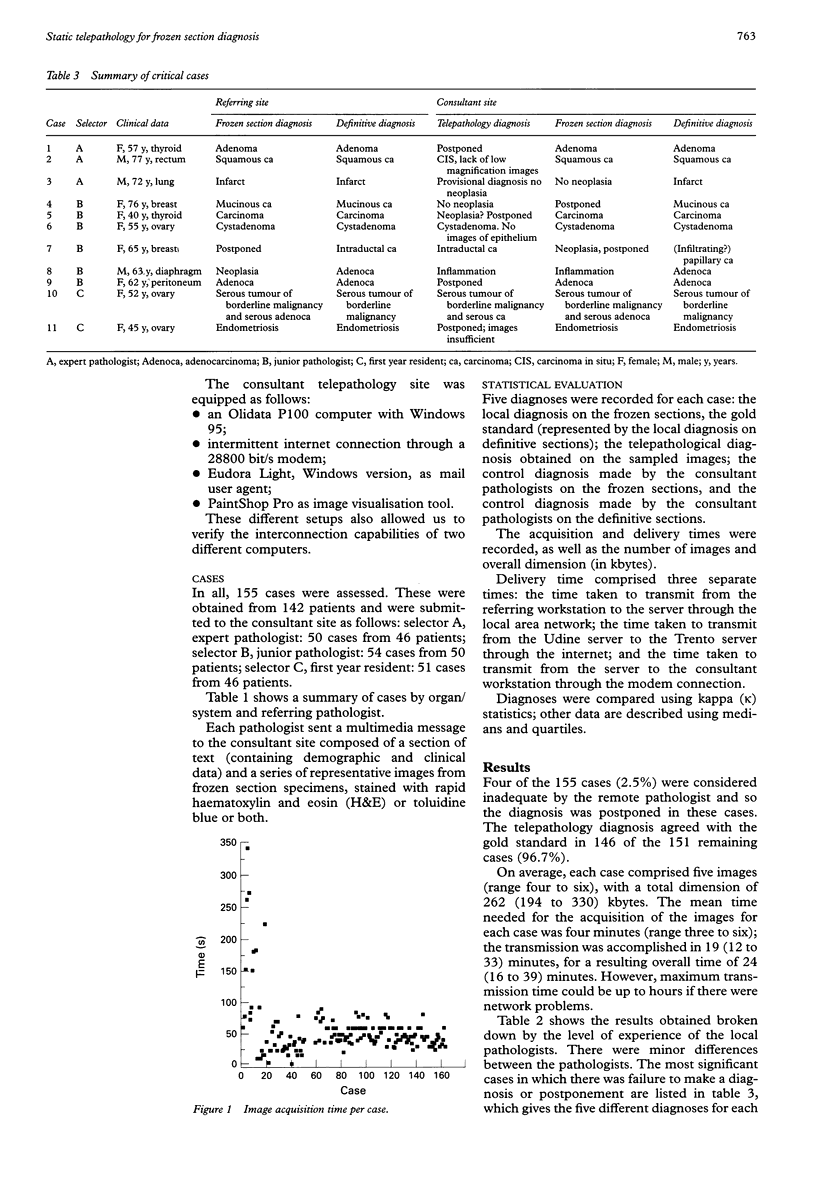
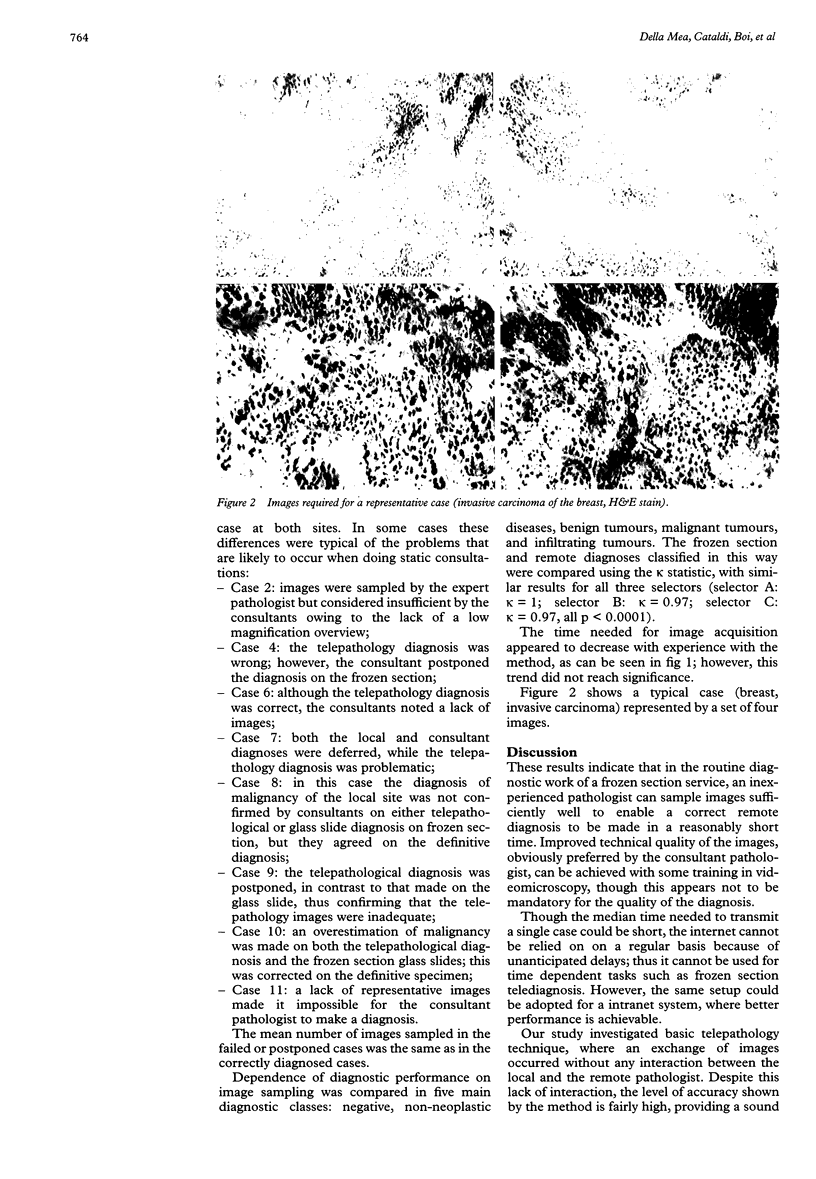
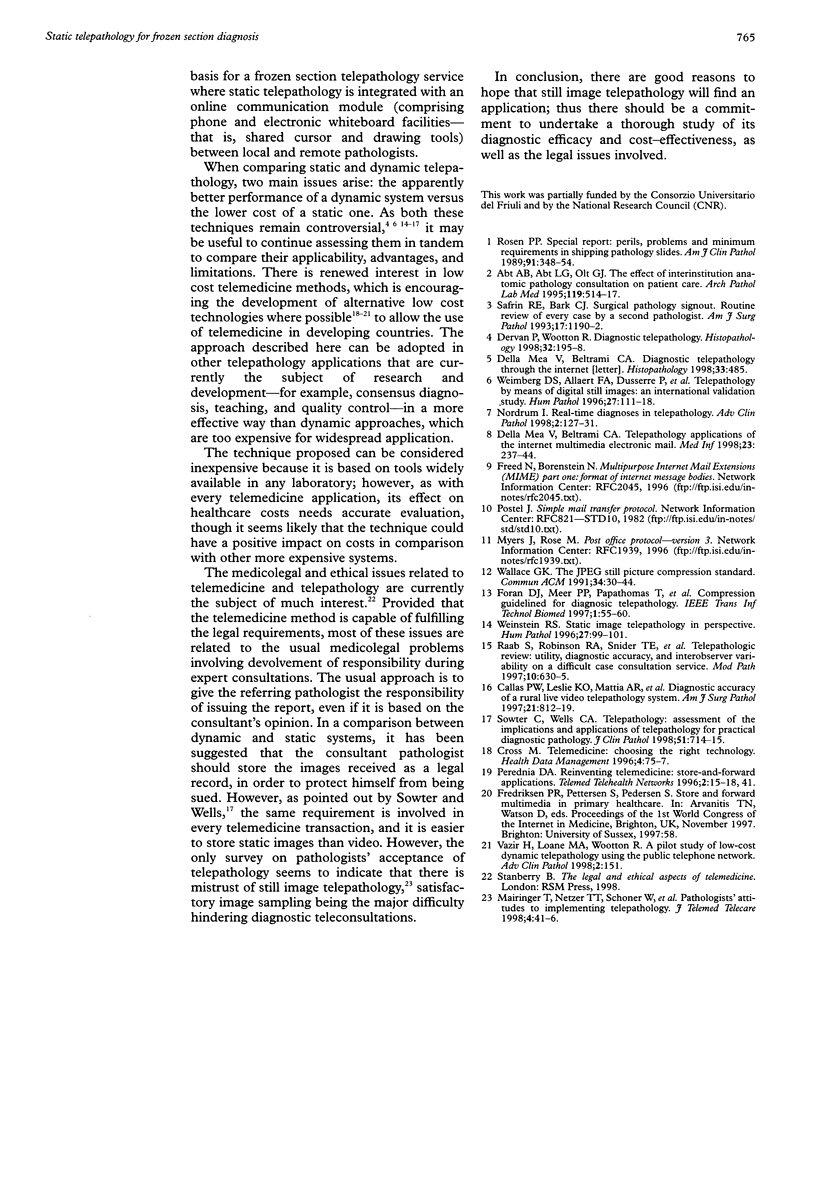
Images in this article
Selected References
These references are in PubMed. This may not be the complete list of references from this article.
- Abt A. B., Abt L. G., Olt G. J. The effect of interinstitution anatomic pathology consultation on patient care. Arch Pathol Lab Med. 1995 Jun;119(6):514–517. [PubMed] [Google Scholar]
- Callas P. W., Leslie K. O., Mattia A. R., Weaver D. L., Cook D., Travis B., Stanley D. E., Rogers L. A., Mount S. L., Trainer T. D. Diagnostic accuracy of a rural live video telepathology system. Am J Surg Pathol. 1997 Jul;21(7):812–819. doi: 10.1097/00000478-199707000-00009. [DOI] [PubMed] [Google Scholar]
- Cross M. Telemedicine. Choosing the right technology. Health Data Manag. 1996 Jun;4(6):75–77. [PubMed] [Google Scholar]
- Della Mea V., Beltrami C. A. Diagnostic telepathology through the Internet. Histopathology. 1998 Nov;33(5):485–485. doi: 10.1046/j.1365-2559.1998.0491a.x. [DOI] [PubMed] [Google Scholar]
- Della Mea V., Beltrami C. A. Telepathology applications of the Internet multimedia electronic mail. Med Inform (Lond) 1998 Jul-Sep;23(3):237–244. doi: 10.3109/14639239809001404. [DOI] [PubMed] [Google Scholar]
- Dervan P. A., Wootton R. Diagnostic telepathology. Histopathology. 1998 Mar;32(3):195–198. doi: 10.1046/j.1365-2559.1998.00345.x. [DOI] [PubMed] [Google Scholar]
- Foran D. J., Meer P. P., Papathomas T., Marsic I. Compression guidelines for diagnostic telepathology. IEEE Trans Inf Technol Biomed. 1997 Mar;1(1):55–60. doi: 10.1109/4233.594046. [DOI] [PubMed] [Google Scholar]
- Nordrum I., I Real-time diagnoses in telepathology. Adv Clin Path. 1998 Apr;2(2):127–131. [PubMed] [Google Scholar]
- Perednia D. A. Store-and-forward teledermatology. Telemed Today. 1996 Jul-Aug;4(4):18–21. [PubMed] [Google Scholar]
- Raab S. S., Robinson R. A., Snider T. E., McDaniel H. L., Sigman J. D., Leigh C. J., Thomas P. A. Telepathologic review: utility, diagnostic accuracy, and interobserver variability on a difficult case consultation service. Mod Pathol. 1997 Jun;10(6):630–635. [PubMed] [Google Scholar]
- Rosen P. P. Special report: perils, problems, and minimum requirements in shipping pathology slides. Am J Clin Pathol. 1989 Mar;91(3):348–354. doi: 10.1093/ajcp/91.3.348. [DOI] [PubMed] [Google Scholar]
- Safrin R. E., Bark C. J. Surgical pathology sign-out. Routine review of every case by a second pathologist. Am J Surg Pathol. 1993 Nov;17(11):1190–1192. [PubMed] [Google Scholar]
- Sowter C., Wells C. A. Telepathology: assessment of the implications and applications of telepathology for practical diagnostic pathology. J Clin Pathol. 1998 Oct;51(10):714–715. doi: 10.1136/jcp.51.10.714. [DOI] [PMC free article] [PubMed] [Google Scholar]
- Vazir H, Loane MA, Wootton R. A pilot study of low-cost dynamic telepathology using the public telephone network. Adv Clin Path. 1998 Apr;2(2):151–151. [PubMed] [Google Scholar]
- Weinberg D. S., Allaert F. A., Dusserre P., Drouot F., Retailliau B., Welch W. R., Longtine J., Brodsky G., Folkerth R., Doolittle M. Telepathology diagnosis by means of digital still images: an international validation study. Hum Pathol. 1996 Feb;27(2):111–118. doi: 10.1016/s0046-8177(96)90363-9. [DOI] [PubMed] [Google Scholar]
- Weinstein R. S. Static image telepathology in perspective. Hum Pathol. 1996 Feb;27(2):99–101. doi: 10.1016/s0046-8177(96)90361-5. [DOI] [PubMed] [Google Scholar]



